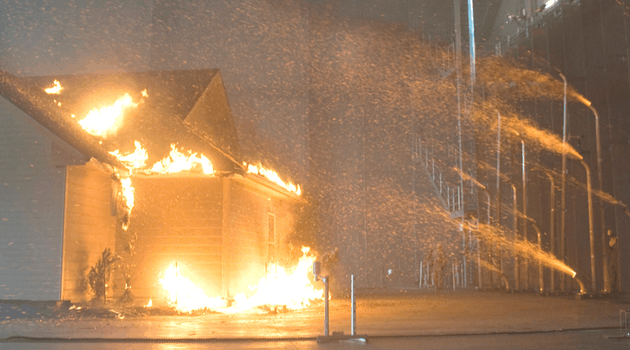Reposted from the Fire Adapted Communities Learning Network blog

I was nine years old when my dad's family home burned in the Oakland Hills Fire. As a country kid from one of the most fire-prone counties in northern California, I was no stranger to wildfire. Still, I remember the shock of driving through his childhood neighborhood in the weeks after the fire, seeing nothing but the skeletal remains of vehicles and homes — so different than the forest fires that I was used to back in Trinity County.
Those images came back to me a few weeks ago when I gave a presentation at a workshop in Redwood Valley, California. That community, which is in Mendocino County, suffered a devastating wildfire in October, during the same week that fires were burning throughout Sonoma and Napa counties. During the Redwood Valley Fire, nine people were killed and more than 500 structures were destroyed. Now more fires are burning in southern California, and in some ways, it seems that the human connection — the loss of lives, the loss of homes — is the defining feature of this year's fire season in California.

Redwood Valley Fire damage. “In some ways, it seems that the human connection — the loss of lives, the loss of homes — is the defining feature of this year's fire season in California.” Credit: Lenya Quinn-Davidson, Fire Adapted Communities Learning Network
One of my close colleagues at the University of California Cooperative Extension, Yana Valachovic, has no doubt felt the human implications of the 2017 fire season. Her phone has been ringing off the hook for months because of her expertise and experience in home ignitions and home survival: concepts that people are desperate to understand and implement in light of the ongoing losses throughout the state.
In some ways, the research on home survival during wildfire is intuitive; most people understand defensible space concepts and the basics of fuels management. But there are so many ways that most of us could do better — ways that are well illustrated by my own friends, colleagues and family.
Yana talks about how even she — someone who studies this topic — stores paper bags full of her kids' old schoolwork in her attic, right next to the vents. And if you read the literature on this topic, you know that vents represent a major vulnerability during wildfire. Most homes burn from the inside out, meaning that embers make their way into the home through vents and other crevices, and they then ignite fuels inside the house. Once embers infiltrate, it's hard to slow them down — hence the photos we often see of blackened homes surrounded by green trees and intact neighborhoods.

Click on the image above to access Dr. Steve Quarles' new report, Vulnerability of Vents to Wind-Blown Embers
Current research supports the use of finer mesh vent screens (typically a second screen behind the outer screen), and/or temporary vent covers during wildfire events. There is an impressive amount of information available on home venting and fire, including the desired fineness of screen meshes, the use of ridge vents and the appropriateness of unvented attics (PDF, 213 MB). Much of this work comes from the Insurance Institute for Business and Home Safety (IBHS). Steve Quarles leads IBHS's fire-related research program and has published a number of papers on this topic, including a new report, Vulnerability of Vents to Wind-Blown Embers.
Homes can also burn from the outside in, thanks again, in large part, to embers. A few years ago, when a wildfire came within a half mile of my mom's house, I found her gutters packed with dry leaves. This is a classic problem, and one that I was surprised to see at my own mom's house. How did we let the gutters fill up like that, knowing what we know? Gutters full of debris, if ignited, will provide direct flame and ignition to the edge of the roof; if the roof is not adequately protected by metal flashing, or if the gutter is below the roof edge exposing the vulnerable roof sheathing, it can be difficult to keep fire from spreading from the gutter into the house. In 2010, when Quarles was with University of California, he co-authored a great publication that discusses rain gutters, vents, roofing, decks and other home vulnerabilities (PDF, 4.87 MB).
There is also a fair amount of research on features adjacent or attached to the home — features like decks, fences and landscaping (PDF, 416 KB). Still, on a recent trip to a research station in southwest Georgia (a place known for its fire science research and active fire management), I was surprised to see that the landscaping around every building had a thick mulching of longleaf pine needles — literally one of the most flammable types of leaf litter in the world. It looked great but wouldn't be particularly helpful if a fire came through. And IBHS wildfire demonstrations, like this one from 2011, have shown that mulches and other near-home landscaping can become serious points of weakness during wildfire. (I highly recommend checking out their video demonstrations if you haven't before; they have a lab where they actually burn down full-sized homes.)
Now I know that this information is likely old news to many of you; I hesitated to write about this topic because our readership is probably fairly fluent in the research on home ignitions and survival. But the images of Yana's attic full of well-cured paper, my mom's gutters full of leaves, and the pine needle mulch at the research station in Georgia reminded me that we all have more we can do — even if we're well-versed in how homes burn. Home hardening is, of course, only one facet of fire adaptation, but this year's fires reinforced the importance of all efforts at all scales, from the vent and the gutters to the community wildfire protection plan and the prescribed burn.